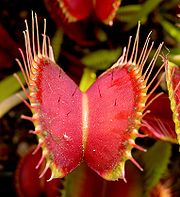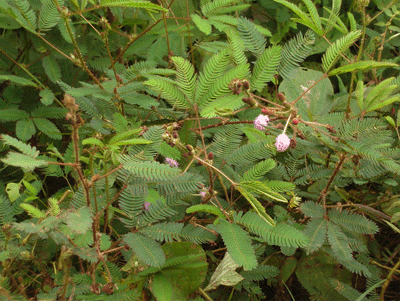
Rapid plant movement
Encyclopedia

Venus Flytrap
The Venus Flytrap , Dionaea muscipula, is a carnivorous plant that catches and digests animal prey—mostly insects and arachnids. Its trapping structure is formed by the terminal portion of each of the plant's leaves and is triggered by tiny hairs on their inner surfaces...
closes its trap in about 100 milliseconds
Millisecond
A millisecond is a thousandth of a second.10 milliseconds are called a centisecond....
. The Dogwood Bunchberry's flower
Flower
A flower, sometimes known as a bloom or blossom, is the reproductive structure found in flowering plants . The biological function of a flower is to effect reproduction, usually by providing a mechanism for the union of sperm with eggs...
opens its petals
Petal
Petals are modified leaves that surround the reproductive parts of flowers. They often are brightly colored or unusually shaped to attract pollinators. Together, all of the petals of a flower are called a corolla. Petals are usually accompanied by another set of special leaves called sepals lying...
and fires pollen
Pollen
Pollen is a fine to coarse powder containing the microgametophytes of seed plants, which produce the male gametes . Pollen grains have a hard coat that protects the sperm cells during the process of their movement from the stamens to the pistil of flowering plants or from the male cone to the...
in less than 0.5 milliseconds. The record is currently held by the White Mulberry
White Mulberry
Morus alba, known as white mulberry, is a short-lived, fast-growing, small to medium sized mulberry tree, which grows to 10–20 m tall. The species is native to northern China, and is widely cultivated and naturalized elsewhere...
tree, with flower movement taking 25 μs, moving petals to velocities in excess of half the speed of sound
Speed of sound
The speed of sound is the distance travelled during a unit of time by a sound wave propagating through an elastic medium. In dry air at , the speed of sound is . This is , or about one kilometer in three seconds or approximately one mile in five seconds....
—near the theoretical physical limits for movements in plants.
These rapid plant movements differ from the more common, but much slower "growth-movements" of plants, called tropism
Tropism
A tropism is a biological phenomenon, indicating growth or turning movement of a biological organism, usually a plant, in response to an environmental stimulus. In tropisms, this response is dependent on the direction of the stimulus...
s.
Charles Darwin in 1880 published his last work before his death, The Power of Movement in Plants
The Power of Movement in Plants
The Power of Movement in Plants is a book by Charles Darwin on phototropism and other types of movement in plants. This book continues his work in producing evidence for his theory of natural selection...
.
Plants that capture and consume prey
- Venus FlytrapVenus FlytrapThe Venus Flytrap , Dionaea muscipula, is a carnivorous plant that catches and digests animal prey—mostly insects and arachnids. Its trapping structure is formed by the terminal portion of each of the plant's leaves and is triggered by tiny hairs on their inner surfaces...
(Dionaea muscipula) - Waterwheel PlantWaterwheel plantAldrovanda vesiculosa, commonly known as the waterwheel plant, is the sole extant species in the flowering plant genus Aldrovanda of the family Droseraceae. This plant feeds on small aquatic invertebrates using traps very similar to those of the Venus Flytrap. The traps are arranged in whorls...
(Aldrovanda vesiculosa) - BladderwortBladderwortUtricularia, commonly and collectively called the bladderworts, is a genus of carnivorous plants consisting of approximately 233 species . They occur in fresh water and wet soil as terrestrial or aquatic species across every continent except Antarctica...
(Utricularia) - Certain varieties of SundewSundewDrosera, commonly known as the sundews, comprise one of the largest genera of carnivorous plants, with at least 194 species. These members of the family Droseraceae lure, capture, and digest insects using stalked mucilaginous glands covering their leaf surface. The insects are used to supplement...
(Drosera)
Plants that move leaves for other reasons

- Sensitive PlantMimosa pudicaMimosa pudica , is a creeping annual or perennial herb often grown for its curiosity value: the compound leaves fold inward and droop when touched or shaken, re-opening minutes later...
(Mimosa pudica) - Catclaw BrierMimosa nuttalliiMimosa nuttallii, the Catclaw Brier or Sensitive Brier, is a herbaceous perennial legume in the subfamily Mimosoideae. It has a trailing semiwoody vine covered with small recurved prickles that can be painful to bare skin....
(Mimosa nuttallii) - Telegraph plant (Codariocalyx motorius)
- Partridge peaChamaecrista fasciculataChamaecrista fasciculata is a species of legume native to most of the eastern United States. It is an annual which grows to approximately 0.5 meters tall...
(Chamaecrista fasciculata) - Sensitive partridge peaChamaecrista nictitansChamaecrista nictitans is a herbaceous species of legume widely distributed through the temperate and tropical Americas...
(Chamaecrista nictitans) - Roemer sensitive briar (Schrankia roemeriana)
- Yellow Neptunia (Neptunia luteaNeptunia luteaNeptunia lutea, the Yellow-puff, is a trailing, vine-like perennial plant of the legume family Fabaeceae. Its stems are covered with soft spines, but is not nearly as prickly as its cousin, the Sensitive Brier ....
)
Plants that spread seeds or pollen by rapid movement
- Squirting cucumber (Ecballium agreste)
- ImpatiensImpatiensImpatiens is a genus of about 850–1,000 species of flowering plants, widely distributed throughout the Northern Hemisphere and tropics. Together with the puzzling Hydrocera triflora, this genus makes up the family Balsaminaceae...
(Impatiens x) - Sandbox TreeSandbox TreeHura crepitans , the Sandbox tree, also known as Possumwood and Jabillo, is an evergreen tree of the spurge family , native to tropical regions of North and South America in Amazon Rainforest. It is recognized by the many dark, pointed spines and smooth brown bark...
- TriggerplantTriggerplantStylidium is a genus of dicotyledonous plants that belong to the family Stylidiaceae. The genus name Stylidium is derived from the Greek στύλος or stylos , which refers to the distinctive reproductive structure that its flowers possess...
(All Stylidium species) - Canadian Dwarf Cornel (aka DogwoodDogwoodThe genus Cornus is a group of about 30-60 species of woody plants in the family Cornaceae, commonly known as dogwoods. Most dogwoods are deciduous trees or shrubs, but a few species are nearly herbaceous perennial subshrubs, and a few of the woody species are evergreen...
Bunchberry) (Cornus canadensis) - White MulberryWhite MulberryMorus alba, known as white mulberry, is a short-lived, fast-growing, small to medium sized mulberry tree, which grows to 10–20 m tall. The species is native to northern China, and is widely cultivated and naturalized elsewhere...
(Morus alba) - Orchid (All Catasetum genus)
- Dwarf Mistletoe (Arceuthobium)
- Witch-hazelWitch-hazelWitch-hazel is a genus of flowering plants in the family Hamamelidaceae, with three species in North America , and one each in Japan and China...
(Hamamelis) - Some FabaceaeFabaceaeThe Fabaceae or Leguminosae, commonly known as the legume, pea, or bean family, is a large and economically important family of flowering plants. The group is the third largest land plant family, behind only the Orchidaceae and Asteraceae, with 730 genera and over 19,400 species...
have beans that twist as they dry out, putting tension on the seam, which at some point will split suddenly and violently, spraying the seeds metres from the maternal plant. - MarantaceaeMarantaceaeThe Marantaceae or arrowroot family is a family of flowering plants known for its large starchy rhizomes. It is sometimes called the prayer-plant family...

